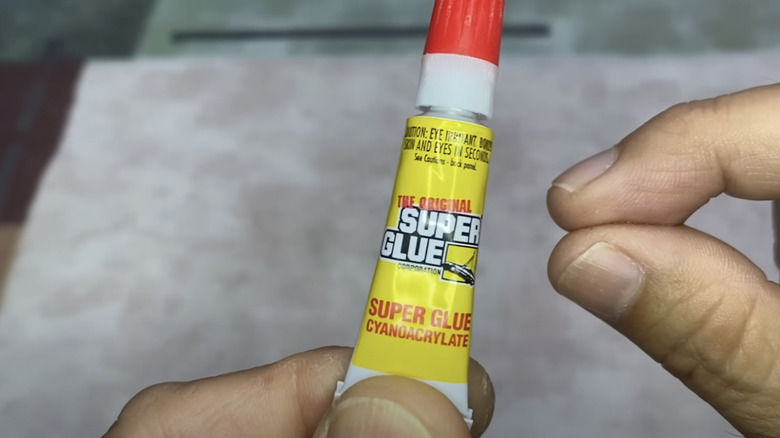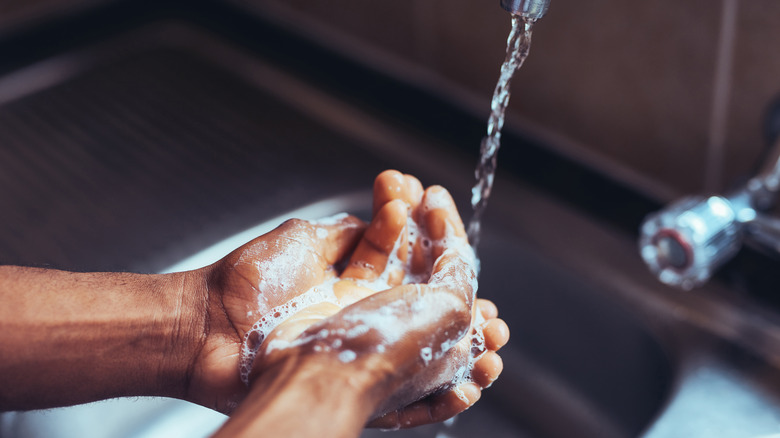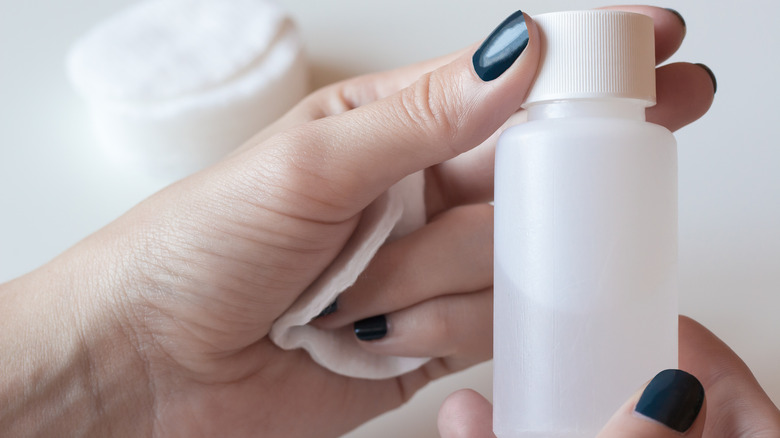Think Twice Before Trying This Bizarre Hack To Remove Super Glue From Your Skin
If you've ever used super glue and ended up with it adorning your skin instead of your project, you're not alone. Whether it's a wayward drop on your arm or a little residue instantly stuck to your fingers, it can be a frustrating experience, especially when you're scrambling to remove it quickly. While some household hacks suggest that butter is one ingredient that can help loosen the fast-drying adhesive from your skin, it's not the quickest method — acetone can instantly break down super glue, though it's a harsher chemical.
Super glue, which contains the adhesive cyanoacrylate, generally doesn't cause serious harm to your skin, but it can cause some minor issues depending on the amount, contact time, and how you try to remove it. If the glue is on your fingers or other areas where skin meets, it can briefly bond them together. This shouldn't cause harm but can be uncomfortable until the glue dries and peels apart naturally. However, if you try to forcefully remove the glue by frantically scraping or picking, you can damage the top layer of your skin, leading to abrasions or even minor cuts, which can increase the risk of infection and leave temporary scarring.
The glue can temporarily irritate your skin, causing redness, itching, or a mild burning sensation. This typically subsides within a few hours. If the glue doesn't come off after a couple days or you develop a rash, consult a doctor.
The limitations of butter
There are many super glue removal hacks you probably haven't thought of before, and some, like using Coca-Cola to remove dried glue, may seem strange. However, the first thing you want to do is soak the affected area in warm, soapy water for several minutes. The soap can help loosen the glue's bond, and then you can gently rub the area to remove it. If that doesn't help, an oil-based solvent like butter may also be able to loosen the glue's grip.
While oil — including the fat content in butter — might help loosen the glue sometimes, it's not foolproof. If you have nothing else on hand or didn't get a lot of glue on you, it doesn't hurt to use it, but it does have some limitations. Notably, it doesn't help dissolve super glue as acetone does, so while it might help unstick your fingers, it might not be strong enough to fully remove the substance, especially if it's well-bonded. Though it's easy to get flustered when your skin is stuck together, remember that getting super glue on your skin is more of a nuisance than a danger. That being said, there are faster ways to remove it quickly outside of butter.
Using acetone to remove super glue from skin
Acetone (or nail polish remover) is a common and effective solution for removing super glue from the skin, especially once it has dried. However, dermatologist John Anthony told Cleveland Clinic that it damages the skin more than other methods. Avoid contact with sensitive areas like the face, including the eyes or mucous membranes. For the skin bonded by super glue, carefully dab a small amount of acetone onto the affected area. Be patient and gentle, and resist the urge to pull. Instead, try carefully peeling your skin apart. Remember: Patience is key, and yanking carelessly can damage your skin. Once the glue has separated, continue gently rubbing the area to dislodge any that remains.
Thoroughly wash the area with soapy water to remove any residue. To combat potential dryness from the acetone, apply a soothing moisturizer to your skin. If you don't have any acetone, use rubbing alcohol or vinegar as a substitute. If the glue is on a sensitive area, you have a large amount of glue stuck, or you experience irritation or discomfort, seek medical attention for safe removal.


